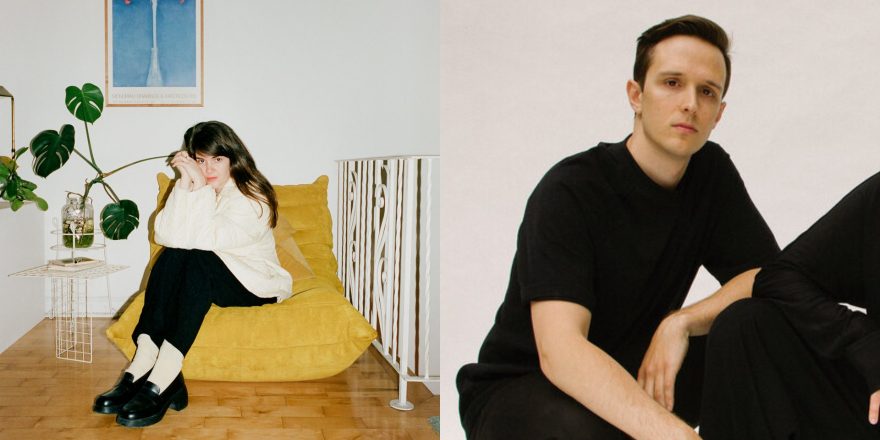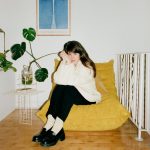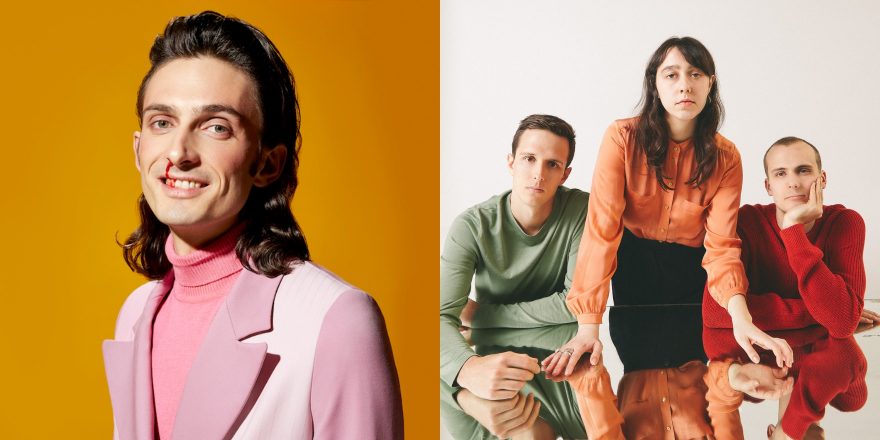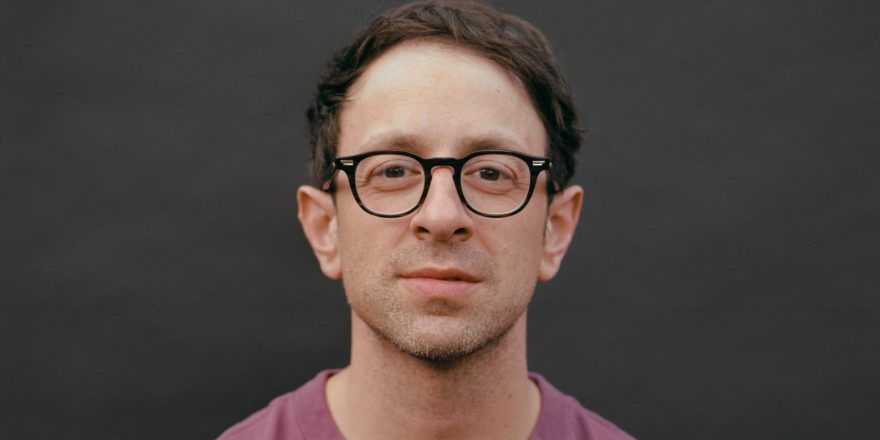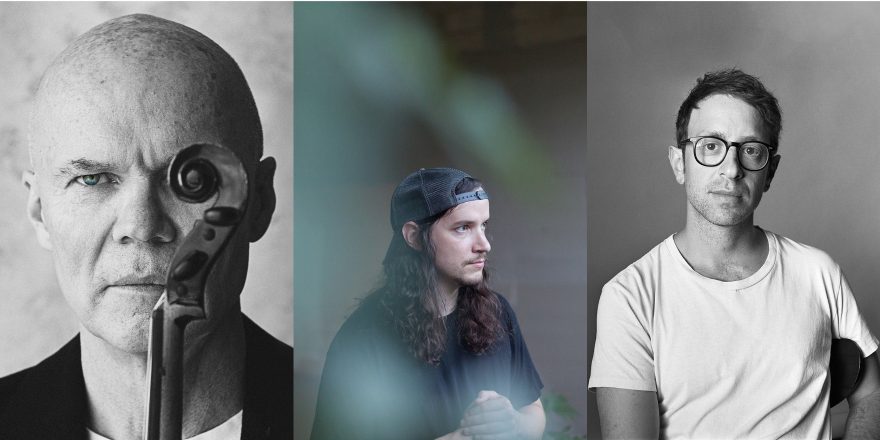Tess Roby is an artist and musician based in Montreal; Austin Tufts is a drummer and producer, and a member of Braids, who is also based in Montreal. Austin recorded and mixed Tess’s new record, Ideas of Space — out today on SSURROUNDSS — and to celebrate its release, the two caught up about the process of creating it.
— Annie Fell, Editor-in-chief, Talkhouse Music
Tess Roby: Hi, Austin! Where are you right now?
Austin Tufts: I just got back to Victoria, where I now live. I just finished up my first tour with Braids after years of just sitting at home and recording and not getting to play shows, so it felt really good.
Tess: So crazy. I just played with Men I Trust last night — I’m in Toronto right now and we had a sold out show at the Danforth Music Hall, and there’s another happening tonight. It really felt crazy being back on that stage.
Austin: No kidding.
Tess: It was honestly wild. I’d played two shows since the end of last year. This was the first show of 2022, but both of those shows were pretty small last year. When I walked out on stage last night, people were right at the front of the barriers and the whole venue was full, and it’s like a thousand people. I almost cried — I put my face down in my hands and just had this moment of just absolute gratitude for being able to play again. Just amazing.
Austin: The catharsis aside, did you feel a little bit weird doing that? Like being back in a room full of so many people, just all this, like, germ-phobia for the last couple of years.
Tess: I definitely have germ-phobia in the back of my brain, but I have to put it aside because I have no control, you know? But what was crazy was I hadn’t been sitting at a merch table for a long time with crowds of people walking around. I had my mask on and people would come up and be like, “When’s her album coming out?” And I’d be like, “Oh, it’s me, it’s me!” [Laughs.]
Everything just feels wild right now. There’s so much stress related to coming back to the stage and getting COVID and having your tour taken away. We were supposed to play with Austra on Tuesday night of this week, and the show was canceled on Sunday because one of their members got COVID. It’s just so volatile.
Austin: Everything is very precarious. Nothing’s happening until it’s happening, seems to be the general sentiment right now. Everyone’s just really bullish — just book a bunch of shows, and if it gets to happen, it gets to happen.
Tess: Yeah. It feels like life as a touring artist right now is not sustainable. So we’ll see what happens in the future. But we should talk about this record we made together! I feel so happy when I think about the whole process and whenever we get to see each other, which now is a little less because, A. we’re not working on the record, and B. you moved to Victoria.
Austin: Yeah, last time we got together we were approving the test pressings for the record. That was such a cathartic moment, hearing the fruits of that labor. You have such a clear vision of what you want from start to finish, and we just get so swept up in that vision while we were creating that it’s hard to ever have the full picture. We were both just so focused on actually making the thing, and then to be able to sit back and listen as a listener for the first time ever… Like even when I was mixing, it’s really hard to dissociate your creator brain from your music appreciator brain, and listening to those test pressings was the first time I got to listen to your record as a spectator. I was so happy, I was shedding tears. We were laying there on the floor in your friend’s apartment, basically just basking in the sun, listening to your record on vinyl. It was a very beautiful experience.
Tess: Yeah, it brought back so many memories of making the record. I remember one thing that you said to me when we were taking a lunch break at the studio was just to enjoy the process and to live in the moment and to love every step, and to not to go too far into thinking about what it could be. I know that so much was taken away from you with the Braids record, with COVID coming in, and you had that realization of, Wow, I just wish we had basked a little bit more in the moment of making that record. So that really was a poignant thought for me, and I really tried to love every moment that we were in the studio. And I knew we were making something really special and it was just me and you who knew about it. I always keep things so secret, and it was so cool to invite you into this world that I don’t really share with anyone.
Austin: So was this your first time letting somebody in before the end of the process, before the mixing stage?
Tess: Yeah. My first record I had done with Peter Woodford at The Bottle Garden [a studio in Montreal], and then my brother had recorded with me on the first record, but I felt like this was the first time that I really let somebody into my whole universe. I felt like we were really building songs together. You weren’t just my recording engineer, you weren’t just my drummer, not just my mixing engineer — you were all of those things and more. It felt like such an interesting process to let you in, in that way.
Austin: I mean, I could tell when you first came by the studio and we listened to the first three songs that you had — it was “Eyes Like Babylon,” “Walls Surrounding Water,” and “Ideas of Space.”
Tess: And they were all drumless.
Austin: Yeah, it was just the bed tracks that you had done to tape. At that moment hearing them, I could tell that there was a space for me to exist on this album and for my ideas to help elevate what you were trying to do. It was just so clear right out the gate. It not only lit up my own creative brain, but I heard so much presentation-wise and parts-wise, specifically from a percussion and drumming perspective. But I could also tell that there was an emotional space and an emotional vulnerability that you were coming from that was very honest. When somebody presents that kind of openness and vulnerability, you have to treat it with a sanctity. You can’t take that for granted, especially when somebody is a solo artist and they’re used to working totally self-directed and by themselves. To let somebody into their world, it’s a very beautiful and sort of sacred thing. So I could tell that there was a vibe and an openness to what I was suggesting and what we were talking about, and even just the emotional vibrations that we felt together in that room, listening on the studio monitors that first time to those tracks.
Tess: And that was the day we met as well.
Austin: We’d never met. I came in and was like, “What’s up?” And then we just went straight into listening to these songs. It’s pretty rare that I hear unfinished demos and actually, like, cry. [Laughs.] It was crazy. “Eyes Like Babylon,” really — that was the track that sold me on being like, I need to get involved with this album, and I want to know you as a person and I want to know you as a creator.
Tess: Yeah. I want to talk about that song, because I remember when we were recording that one, I was really chasing this cinematic, orchestral, deep, warm drum tone, and you hear it on that song with the cymbal. And actually, the symbols and the rising in that song, it kind of — did you ever watch The Snowman? It’s a British animated Christmas short film. There’s very cinematic and orchestral music that accompanies it. There are these big cymbals, and those cymbals ended up really reminding me of some of the music in that. But I remember when you were recording that song, you saying, “Wow, this isn’t necessarily what I would have expected.” I was curious to ask you about when you work with artists and they take you in another direction, what do you take away from that? Does it inspire you, and do you learn things from those instances?
Austin: That’s 100% why I do this. And that’s one of the coolest things, I think, about being a drummer first and foremost, is that it’s by nature a collaborative instrument. It’s not really until kind of recently that drums have ever even taken a focal point as a feature artist. Like “OK, I’m going to make a drum record.” And now there are some people doing this, and it’s really interesting and cool. But I think that my involvement always in music has been a collaborative one. It’s just, how can I learn from and absorb other people’s creative worlds and step inside of them? So when we’re in the studio together and you’re pushing me to try things that I wouldn’t necessarily go for if I was left in a vacuum, that’s the most exciting thing, because in a way, it rewires your creative brain.
If you’re only ever surrounded by your own ideas, you’re going to be limited by what you can think up. Which is not necessarily a bad thing, and I think that works for some creators. But when you’re exposed to somebody else’s world — when I come into the studio, I’m not just in the studio with you that day. I’m in the studio with everything that you’ve done and all the people that you’ve worked with and your family and all of your history and heritage and the things that you listen to. One little creative idea that you have has the power to change the way that I think about music forever. And I love that. That’s what I thrive for.
Coming back to me making that comment at lunchtime about needing to make sure that you’re enjoying the moment, because you never know where things will go, and that kind of presence that comes out of that kind of working — it’s things like that, concepts that you pick up when you’re collaborating with people, that really reshape the way that you that you make things. Working with you in particular, regarding the drums, you didn’t want any bright cymbal tones or hi-hats or anything. When we were doing all the drum tracking for the acoustic drums, there was no high hats on anything, no sticks on cymbals. It was all just deep, earthy toms and a little bit of dirty, kind of murky drum machine stuff.
Tess: Yeah, the LinnDrum.
Austin: Yeah, and I love that. I sort of came up as a jazz drummer — it’s a lot more about cymbals and fast transients and bright sounds, and then working with pace and density. Working with you, you sort of demanded — and I say that in the most respectful way, there was never a moment in the studio where you didn’t know what you wanted — “it needs to be lower and deeper and darker and warmer.” You were pushing for this warmth, and from a drumming perspective, that actually put me on a bit of a kick that has translated into some of the more recent records that I’ve been working on. And even into the new Braids record that we just finished. You kind of made me fall in love with toms again.
Tess: [Laughs.] I love toms.
Austin: I’m so glad. Coming up, I was really into toms, but I had kind of stepped away from that and got back to more pocket drumming and kick snare and hi-hats, and playing more structured beats. But then disassembling the drum kit again with you in the studio over those days and just being like, “OK, we’re going to think about this very modularly, and it’s going to be dark, warm toms leading the thing,” it was awesome. And now I’m way deep into toms again.
Tess: Amazing. Yeah, the first three days we were recording were just a few weeks before the pandemic started, and we had absolutely no idea what was coming. But I really have some nice memories of those first few days we were in the studio together. Notably, recording the drums for “Ideas of Space.” We had tried so many things and nothing was hitting. I was getting tired, we’d been there all day, and I was like, “I don’t know. Like, maybe it’ll just be a drumless track.” And then something clicked. We both were on the drums — I was set up with a low tom, and something started happening. I don’t remember the exact specifics of it, but you were like, “Let’s chase this,” and we stayed in the studio very late and we chased it. And that changed “Ideas of Space” forever. It gave it this life and this energy. I can only compare it to the energy of “Running Up That Hill” by Kate Bush, which is one of my favorite songs. It has that drive.
And then in the mixing of that song, you added a delay to the piano, which I thought built it so much more. That song has been hard to translate live, because it’s constant the entire way through. You find those ebbs and flows in the song that rise and fall and the energy comes back and then gets stronger and the kick gets stronger.
Austin: There actually is no kick drum in that song.
Tess: No? There I go! It’s just the tom that’s so deep and hefty.
Austin: If I remember back to those sessions, you were just like, “Oh, I just hear something.” You were vocalizing it, and I think I was like, “Here, just play it.” I pulled a tom out into the middle of the room, and then you were just playing, and it was like, Oh, that’s a vibe. And then I grabbed a pair of brushes and started playing on the snare drum at the same time. We just started jamming this thing. You were like, “OK, sweet, why don’t you record your drum part, and then you record my drum part?” And I was like, “No, I like this. This is the vibe right here.” The whole take was one take, a live drum performance. That was a really special moment.
Tess: Definitely.
Austin: It’s weird and it’s floaty and it’s kind of rough, and I think that’s the beauty behind that track. And there’s a lot of delay on the drums, like there’s like some gallop. It just gives it a very galloping, kind of train-like momentum.
Tess: It really sounds beautiful to me. This was my first time, on this album, working with a drummer, with both acoustic drums and then drum programming. I definitely had ideas — like you said, I kind of always knew what to chase once we had started, and what I didn’t like immediately. I remember on “House/Home,” we had done some acoustic drums and I was like, “This is not hitting for me.” Then we started doing some MIDI drums, and I remember telling you I want it to sound like raindrops tapping on a window, and we got that spring reverb in there. I went through a few stages with that song of loving it and then being less confident in it. But I just think it’s, in the end, a really unique song, and the drum production on it is very cool.
Austin: Yeah, that was awesome. And I think one thing that really stands out to me is that, from a production standpoint, you broke the album down into sort of two sides and two approaches. One was the songs that you did on tape, which there was no click tracks really. It was very floaty and free and you were playing to the synth parts that were already laid down, and that gave it a very natural feeling.
And then you wanted to do the other half of the record more meticulously and recording them with digital recordings. It was more loop-based, and more repetitive stuff. We ended up leaning into drum programming heavier on those songs, using drum machines and samples and things like that, and [it was] a bit more constructive. But I think that even whenever we were doing those constructive things, we were always trying to bring a very natural element to it. There was always things that were played within the drum sequences, and we were running them out of amps or back through guitar pedals and getting things sort of dirty and murky.
Across the whole record — I mean, “Path” is pretty clean, I’d say, but for the most part there’s a lot of texture and grit to the drum programming. I think that it was cool, though, to have the dichotomy between the two halves of the record.
Tess: Yeah, I didn’t want just one side to be the drumless, it works as a whole for me. I think the way that I work — where some artists go into the studio to record and they’re like, “OK, we have 60 songs, we’ve gotta make an album, what are we going to do?” But I kind of start with the songs on the album and I’m like, “How am I going to build these songs up?” A record is a record of time, and in this record I hear so much growth, and so much opening myself up to collaborators like you and Joseph [Shabason] and Ouri.
I have so many lovely memories related to the process of making this record and I’m just thankful that, with the pandemic, you and I were able to be together in the studio and have that physical rapport. I was able to learn so much from you and your techniques and your ideas and your way of working. It was a bit sad that I didn’t get to have that opportunity with the other collaborators on my album. But I’m excited for the world to hear it very soon.
Austin: Yeah, you mentioned the album being a record of your life for that chunk of time. I was wondering, if you feel comfortable talking about it, what was going on in your life that felt like it needed to be expressed? Your lyrics are not very literal. I find that they’re very poetic, they’re a little bit surreal.
Tess: I think towards the beginning of the recording, I was at a pretty dark place in my mind where I had taken some time away from making music, and it was really hard to create for me for a while due to things that were happening in my personal life. Every time I did return to music and make a song or a demo, I would get so lost, and I was so happy. I found that I was regaining my strength and my confidence every time that I would write lyrics or chase a melody. It’s really hard to realize anything that’s going on in the moment when you’re so caught up with day to day events and whatnot. But I think there’s this building of confidence that runs throughout the record, and me leaving behind the negativity in my life and trusting myself and moving forward. And, on the other side of things, knowing that what’s going to help you move forward in life always is what you do best and what you love doing, which for me is making music and making art, making photographs. So I feel a lot of confidence on this album that has lifted me up and lifted me through the dark times.
Austin: I think that you can hear that joy in a lot of the songs. I think it’s cool, though, that it wasn’t so much like, there was something that you needed to say, so you wrote lyrics. It was like you went to music as a place of regenerative healing and spiritual wellness. Just the act of making was an essential part of personal growth.
Tess: It’s very rare that I sit down and write lyrics, or have any trouble at all writing lyrics. They come so naturally in the moment that I’m writing the melody.
Austin: You usually write melodies and lyrics together? You’re not just sitting there writing poetry, and then setting that to a melody.
Tess: Almost never. It’s all very intuitive. Something my dad used to always say was, “The melodies are always there and you just pick them out of the air.” That’s where the lyric, “Ringing in the air,” in my song “Catalyst” on my first album comes from. I really, truly do believe that there’s so much energy around us and when you can tone everything else out — phones, daily life problems, whatever — and you can focus in on that energy, it’s going to come to you and it’s there. And you can take those lyrics and those melodies, and that’s the heart of it all, really.
Austin: Yeah. It’s maybe a little woo-woo or something, but I love the idea that music is always flowing around you, and there’s this energy of ideas. It’s like a river, basically. There was an instructor that I had when I was studying at McGill that would talk about this river flowing overhead. It’s just like a river of ideas and creativity and musical phrases and lyrics, and it’s just flowing constantly, and all you have to do is just stick your hand up and grab out what you need. It’s almost like allowing our bodies to be these conduits for creativity, and just sticking our little antennas up into this river of creativity. I’m not a religious person, but it’s like having this kind of divine intervention of creativity flow through you.
Tess: Yeah. I think the most beautiful part of all is those moments of just being so lost in the music. Time doesn’t matter. You’re not looking at your phone. I want that every day. I hope that one day, that can be my every day.


